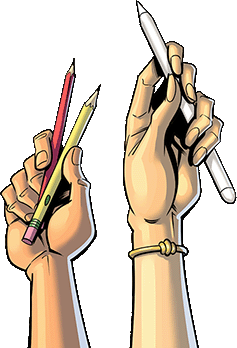Comic Book Page Technical Specifications
August 21, 2020
Making your own comic book is much easier than it used to be thanks to improvements in the technology required to format and print them. Because of how popular comics are online, indie writers and artists can team up to create their own comics and self-publish them.
However, creators must be mindful of technical specifications that can vary between comic book size and type. Trim size, file type, and even the number of pages can all have an impact on the final product.
Before even beginning to draw your comic, make sure you have familiarized yourself with the technical specifications for your work. You will need to decide on a page size before you start, especially if you’ll be drafting sketches digitally.
Saddle Stitch vs Square Bound
Most individual comic book issues use saddle-stitch binding with special printing staples. This inexpensive method allows comic books to be printed quickly and distributed to a wide audience for a low price. However, these booklets must have a page count in multiple of four, and have a maximum of 64 interior pages.
Square bound books have a minimum of 60 pages, due to the methods used to hold the pages securely together. Special orders can be placed for books of over 260 pages. Although square bound books look great on a bookshelf, they are slightly more expensive than saddle-stitch binding and
Book Formats and Sizes
A single page in a standard comic book measures 6.625” x 10.25”. However, artists need to keep all important details at least .125” inside the edge of the page. This “safe zone” ensures that minor irregularities in trimming during the printing process do not interfere with the quality of your final art.
There is also a bleed area that extends .125” beyond each edge of the page. When drawing full-bleed art, make sure the art extends all the way through the bleed in order to prevent small white gaps from appearing during printing.
Industry standards specify that files should be submitted at 300 dots per inch (dpi) to ensure a high-quality print. You can use your printer’s file templates and specifications to make sure your file has high enough resolution, and to help you follow bleed and safe zone guidelines.
Manga and Magazine Size
Manga size comics have a trim size of 5.5” x 7.75”, and like standard size comics, they have a .125” safe zone inside the trim and a .125” bleed. Magazine size pages are 8” x 10.5” with the same safe zone and bleed.
Like with standard size, make sure your sketches and lineart are done at 300 dpi. Your final files will be quite large, but this is necessary to ensure a quality print. Manga size artists, in particular, should consider drawing at a larger size if scanning in hand-drawn lineart, due to the small final size and the need for small details to render clearly.

Color Options
Comix Well Spring offers both black and white and full color printing. Black and white printing options and pricing includes grayscale. Both black and white and color pricing includes full color covers.
Black and white comics can be printed on either 60# or 70# matte paper. Full color printing can be printed on glossy 80# paper in addition to the previous two options. All three options are sturdy enough to create professional-looking final results, but 70# and 80# paper offer an even better finish for serious comic collectors.
Keep in mind that your color scheme affects what file format you should save in. Black and white comics should be exported in uncompressed bitmap (.TIFF) format, because other file formats may cause the lines to be slightly blurred. Full color and grayscale comics can be saved in JPEG and Print Quality PDF formats.
Troubleshooting Printing Problems
If you’re printing a comic for the first time, we strongly recommend getting a printed proof to ensure that all colors print correctly. It is normal for colors to print darker than they appear on your monitor, since your monitor is backlit. A printed proof can help you remedy any issues before the print run is completed.
It’s also wise to keep word bubbles, sound effects, and other details on a separate layer of your files. This makes it easier to resize or move them if it turns out they’re too close to the trim line.
Your printer will let you know if any other issues with file size or layout arise during printing. Using the provided templates for your print size will help minimize problems during the printing process.
Making Your Comic Book Real
Comic book veterans and rookie artists need to take extra care to make sure their final product is exactly as they intended. Since printing and illustrating technologies have improved so much, though, it’s easy to make minor fixes and prevent misprints.
Comix Well Spring has the combination of comics knowledge and printing expertise you need to make your comic a success. We specialize in full color printing of books, trading cards, tablecloths, banners, and more. We provide a wealth of technical knowledge and can walk you through any questions that come up during the ordering process.
We understand that your comic is your passion project, and we’re here to help you make it happen. Contact our customer service team at (734) 345-6805 if you need assistance during the ordering process.


